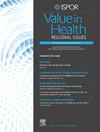伊朗治疗肌浸润性膀胱癌患者的剂量密集型甲氨蝶呤、长春新碱、多柔比星和顺铂化疗方案与吉西他滨和顺铂化疗方案的成本效用分析。
IF 1.4
Q3 HEALTH CARE SCIENCES & SERVICES
引用次数: 0
摘要
目标:在各种癌症中,膀胱癌患者人均终生治疗费用最高。现行指南认可几种以顺铂为基础的新辅助化疗方案。这项成本效用分析旨在比较两种主要的新辅助化疗方案--剂量密集型甲氨蝶呤、长春新碱、多柔比星和顺铂(dd-MVAC)以及吉西他滨和顺铂(GC)--对肌肉浸润性膀胱癌患者的治疗效果,为伊朗的治疗指南提供经济学证据:构建了一个马尔可夫决策模型,其中包含 4 种状态:根治性膀胱切除术后无复发、未进行根治性膀胱切除术、复发和终生死亡。临床结果来自 VESPER(法国泌尿生殖系统肿瘤小组和法国泌尿外科协会 V05)3 期随机对照试验,而成本则来自伊朗本地数据。主要结果包括确定模拟人群的增量成本效益比,支付意愿阈值为 1656 美元(相当于伊朗 2023 年的人均国内生产总值)。成本和收益的年贴现率为 5.8%,并进行了概率和单变量确定性敏感性分析:从伊朗医疗支付方的角度来看,与 4 个周期的 GC 相比,6 个周期的 dd-MVAC 可多获得 0.02 个质量调整生命年,从而节省成本 1 173 491 美元,增量成本效益比为-78 708 870。因此,dd-MVAC 在整个生命周期(23 年)内成为最主要的选择。该模型对治疗期间复发和毒性概率的变化最为敏感:根据这项研究的结果,与 GC 相比,dd-MVAC 在伊朗医疗系统中是一种为每位患者节省成本的治疗方案,其效用更优。本文章由计算机程序翻译,如有差异,请以英文原文为准。
Cost-Utility Analysis of Dose-Dense Methotrexate, Vinblastine, Doxorubicin, and Cisplatin Chemotherapy Regimen in Comparison With Gemcitabine and Cisplatin Chemotherapy Regimen in the Treatment of Patients With Muscle Invasive Bladder Cancer in Iran
Objectives
Bladder cancer incurs the highest lifetime treatment cost per patient among various cancers. Current guidelines endorse several cisplatin-based regimens as neoadjuvant chemotherapy. This cost-utility analysis aimed to compare 2 primary neoadjuvant chemotherapy regimens—dose-dense methotrexate, vinblastine, doxorubicin, and cisplatin (dd-MVAC) and gemcitabine and cisplatin (GC)—for patients with muscle-invasive bladder cancer, providing economic evidence to inform treatment guidelines in Iran.
Methods
A Markov decision model was constructed, incorporating 4 states: after radical cystectomy without recurrence, no radical cystectomy, recurrence, and death over a lifetime horizon. Clinical outcomes were derived from the VESPER (French Genito-Urinary Tumor Group and French Association of Urology V05) phase 3 randomized controlled trial, whereas costs were obtained from local Iranian data. The main result involved determining an incremental cost-effectiveness ratio within the simulated population, with a willingness-to-pay threshold of 1656 USD (equivalent to Iran’s gross domestic product per capita in 2023). Costs and benefits were discounted at 5.8% per annum, and probabilistic and univariate deterministic sensitivity analyses were conducted.
Results
From the perspective of the Iranian healthcare payer, 6 cycles of dd-MVAC yielded 0.02 greater quality-adjusted life-years compared with 4 cycles of GC, resulting in a cost saving of 1 173 491 USD and an incremental cost-effectiveness ratio of −78 708 870. Consequently, dd-MVAC emerged as the dominant option over a lifetime horizon (23 years). The model proved most sensitive to variations in recurrence and toxicity probabilities during treatment.
Conclusions
Based on this study’s results, dd-MVAC represents a cost-saving treatment regimen per patient in the Iranian health system compared with GC, with superior utility.
求助全文
通过发布文献求助,成功后即可免费获取论文全文。
去求助
来源期刊

Value in health regional issues
Pharmacology, Toxicology and Pharmaceutics-Pharmacology, Toxicology and Pharmaceutics (miscellaneous)
CiteScore
2.60
自引率
5.00%
发文量
127
 求助内容:
求助内容: 应助结果提醒方式:
应助结果提醒方式:


